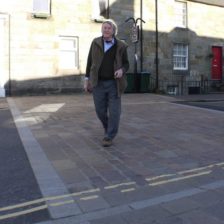Submitted on 16 October 2014 for publication in the November 2014 Kinross Newsletter
Dear Editor
Final Reflections on Referendum Result of 18 September 2014
I have noted the view expressed in some quarters that local councillors should not get involved in nationalissues, like the recent referendum, and write to refute that. I was at the launch of the Better TogetherCampaign in Kinross-shire on 27 May and spoke in support of it.
My fellow opposition councillors Cuthbert and Robertson, along with myself, campaigned hard recentlyin support of a “NO” vote and our opposition to the break up of Britain. My constituents know that Ihave been opposed to the SNP’s separatist agenda all my political life and this will continue. Whathappens nationally in government has a direct effect on local authorities and I think people expect theircouncillors to have a view on such matters and to show leadership, where necessary. The fact remains thatby the end of its current term, the SNP Government will have frozen Council Tax for an unprecedentednine-year period, with consequential effect on public services locally, cuts that they of course blameWestminster Government for, as with most things.
I was heartened and relieved by the outcome of the referendum in Scotland in delivering a clear majorityin support of us remaining part of the UK. In PKC, the NO vote at 62,714 far exceeded the YES vote at41,475 on a very healthy 87% turnout. The highest ward turnout was Kinross-shire at 90% and I alsounderstand that our ward had the highest percentage NO vote and lowest percentage YES vote in ourcouncil area, a fitting tribute to the many folk who campaigned locally.
I voted NO because I don’t believe it is necessary to break up Britain in order to tackle Scotland’sproblems. I still had unanswered questions on citizenship/nationality, currency/financial services, theeconomy, land ownership reform and pensions/welfare after a seemingly interminable referendum debatebordering on a national self-obsession with little regards for the rest of the UK watching from thesidelines. I was completely against the division of Britain’s armed forces in a very uncertain world,opposed to the SNP’s proposed open borders for significant immigration and wanted a say in a promisedreferendum in the UK on reform of the EU.
The NO campaign won despite the flawed Edinburgh agreement negotiated by Cameron since thequestion put invited negativity from the unionist side. If the questions had been: Should Scotland remainpart of the UK? Do you support a Devo Max/Federal solution for Scotland within the UK?, positivedebate could have ensued. There should have been a threshold percentage for such an important voterather than a simple majority. Whilst I support the lowering of the voting age, it should be for allelections.
The referendum bitterly divided communities, families and organisations; the campaign being full ofenmity and intimidation, all caused by nationalism.
I have always supported the Liberal Federal Model for Britain with home rule parliaments for England(preferably outwith London), Northern Ireland, Scotland and Wales, with full tax raising powers to fundtheir domestic programmes whilst a reformed Westminster retains control over currency matters, financialservices, foreign affairs and macro-economic policy. I very much hope that the Smith Commissioncharged with agreeing more powers for Scotland can keep to its tight timescale and get an agreementfrom the parties involved that takes us closer to this model. I do not think that this timetable should belinked to answering the “West Lothian” question on English votes for English laws that Cameron suggested.
It is now time for the SNP Government under Sturgeon to get on with their mandate by using theextensive powers they already possess to make a difference in running Scotland, rather than continuallyadvocating and campaigning that only independence (rejected by the majority of Scots) is a cure-all.
For my part, I continue to work behind the scenes up at Perth on a number of local environmental,planning and road issues of concern to my constituents for future reporting.
Kind regards
Councillor Mike Barnacle
Independent Councillor for Kinross-shire
